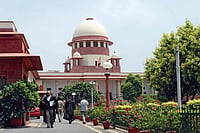The highly publicized demolition of the Supertech twin towers in Noida's Sector 93A, scheduled for Sunday, August 28, has led to much speculation and conjecture among locals as well as city planning experts. Being touted as one of the tallest structures ever to be safely demolished by implosion technique, the 100-ft tall Supertech twin towers have been in the eye of controversy ever since their inception in the late 2000s.
The demolition of the illegally constructed towers inside the Emerald Court housing society premises comes in pursuance of a Supreme Court order which upheld the razing that had previously been ordered by the Allahabad High Court. However, the unforeseen situation has led to the unusual problem that has left many including the 5,000 local residents directly affected by the demolition deeply concerned - the problem of rubble and waste management.
Tonnes of waste
The demolition would be done through a controlled implosion technique for which over 3,700 kg of explosives will be used in the eye-popping event that would also leave behind a whopping 55,000 tonnes of debris to be managed apart from giant smoke and dust clouds that will need to be dissipated.
The buildings measuring a little over 100 metres will literally collapse like a house of cards in a process that would take less than 15 seconds for them to come down, according to project officials.
According to the estimates prepared by the project officials, the demolition of the Apex (32 storeys) and Ceyane (29 storeys) towers would leave behind approximately 35,000 cubic metres of debris. a large part of the debris would be accommodated in the basement of the towers while the remaining would be moved out to an isolated location within Noida and processed scientifically. This means that around 1,200 to 1,300 “truck-loads” of debris would have to be moved out from the site manually.
The controlled explosion is being engineered after covering the areas surrounding the site with 225 tonnes of wired mesh made of galvanised iron and geo-textile approximately 110-km in length, the Quint reported. The cloth will also be used to cover the residential towers around the blast site including Emerald Court and ATS Village societies.
How will the debris be moved out?
Noida planning authorities have stated that 21,000 cubic metres of the debris would be moved out and dumped at an isolated land measuring five to six hectares in city’s work circle seven limits and the remaining would get accommodated in the basement areas of the twin towers where a pit has been made.
AS per Noida Authority’s General Manager (Planning) Ishtiaq Ahmed, post-demolition debris would be managed "scientifically as per rules and guideline".
A final decision on it would remain pending till the go-ahead from the regional pollution control board which is examining a report from Edifice Engineering on debris management.
According to the authorities, 1,200 to 1,300 “truck-loads” of debris would have to be moved out from the site. However, considering the rubble that would be moved out, it is still not clear whether it would be processed there and if yes, then how and over what duration of time. As per reports, all the debris will not go to waste as it will yield an estimated 4,000-tonnes of iron and steel that Edifice plans to use to recover a part of the demolition cost.
The Noida Authority has a construction and demolition waste management plant in Sector 80, with a capacity of 300-tonnes per day.
Settling the dust clouds
As per Mumbai-based Edifice Engineering which is in charge of the demolition along with their South African partner firm Jet Demolitions, it will take nine to 10 seconds for all the explosives to blast in a series making a loud noise. After the blasts, the structures won’t come down all at once and would take four to five seconds to come down completely. The process will create huge plumes of dust and air pollution, which is definitely on top of the Uttar Pradesh Pollution Control Board's (UPPCB) list of concerns. Despite dissipation efforts, the nearby areas are likely to see an increase in PM10 and PM 2.5 levels. PM10 particles are likely to increase because of the coarser particles the blast will emit.
Authorities, however, have noted favourable wind conditions that could be intrinsic in helping to steer the dust away from residential areas. The Jet Demolitions team has been tracking flow of the wind for the past week and found it flowing towards the West. If the same pattern continues, then most of the dust will reportedly blow towards the front side of the twin towers, which is a road followed by an open city park, Edifice Engineering partner Utkarsh Mehta was quoted by PTI. This would prevent the dust from settling within the premises of Emerald Court and ATS Village societies – both in close proximity to the twin towers.
(With inputs from PTI)


























